Geochemistry and Petrology of the Bellecombe Lava Sequence, Enclos Fouqué Caldera, Piton de la Fournaise Volcano (Réunion, France)
Abstract
1. Introduction
1.1. Evolution of the Volcanic Activity
1.2. Petrological Characteristics
- The ‘Steady-State Basalts’ (SSB), representing the main type of basalts emitted by PdF. These products usually display a homogeneous composition (5–8 wt.% MgO; 0.5–1 wt.% K2O; 10–12 wt.% CaO) and a typically aphyric or poorly porphyritic texture, with phenocrysts represented mostly by olivine (>20% in rock volume) and minor clinopyroxene, ±plagioclase as phenocrysts [4]. SSBs are mostly emitted in the summit area of the volcano [38,39];
- Olivine-rich basalts, containing up to 60 wt.% of olivine and with a high and variable MgO content (8–28 wt.%), usually erupted on the flanks of the volcano during eruptions with high emission rates or in the final phases of the eruptions that started with the emission of SSB basalts [38,40,41]. The mm- to cm-sized olivine phenocrysts of these products have been interpreted as antecrysts derived from crystalline mush within dikes [42] or detached from cumulitic bodies or magma reservoirs located at a shallow depth [4,43,44,45];
- Differentiated Alkaline Lavas (DAL) represent a relatively rare group, mostly outcropping at the base of the PdF shield edifice. They are more evolved and alkali-rich (1 < MgO < 5 wt.%; 1 < K2O < 4 wt.%) than the recent products and contain abundant feldspar indicative of shallow magmatic activity which mostly occurred in the early stages of the volcano’s history [4,46,47,48]. The notable abundance of plagioclase in these products has been interpreted as cumulitic in origin, resulting from the dismantling of anorthositic mush in the shallower portions of magma chambers formed during a decrease in magmatic flux and potentially attributable to the older Le Alizés volcano [49].
- The “Abnormal Basalt Group” (AbG) represents a fourth group of lavas, mostly outcropping on the volcano flanks and rare inside the Enclos Fouqué caldera [4,8]. These magmas are relatively depleted in CaO and SiO2 and enriched in FeO, TiO2 and K2O with respect to SSBs. The AbG lavas have alkaline affinity (7.5–10 wt.% MgO; 0.9–1.2 wt.% K2O; 8.5–10 wt.% CaO) and often transport ultramafic enclaves to the surface, these having been ripped from a depth near the mantle–crustal underplating layer [8]. Geophysical and geochemical data associated with their surface emission indicate that these magmas rose from areas at a greater depth than the other products emitted at PdF [44,50,51], having experienced differentiation at the mantle-crust underplating layer (10–15 km b.s.l.), where they are subject to CO2 flushing, magma mixing, crystal recycling/assimilation and contamination with partial melts from metasomatized cumulates [52]. Previous studies [53] have shown that the NW rift zone situated on the volcano’s flank represents a young and active corridor of SSB magmas surrounded by large-volume AbG-type eruptions.
2. Materials and Methods
2.1. Sampling
2.2. Geochemical Analysis
2.3. Textural Analysis and Mineral Chemistry
2.4. X-ray Computed Microtomography and 3D Image Analysis
3. Results
3.1. Geochemistry of the Bellecombe Lava Sequence
3.2. Petrography and Mineral Chemistry
3.2.1. SSB Lavas
3.2.2. DAL: Differentiated AbG Lavas
3.2.3. AbG Lavas
3.3. Vesicle Distribution
4. Discussion
5. Conclusions
- −
- Initial emission of SSB-like products, which today outcrop at the bottom of the sequence;
- −
- A short-lived eruptive period characterized by largely degassed Differentiated Alkaline Lavas;
- −
- Emission of more primitive, volatile-rich and porphyritic lavas of the Abnormal Basalt Group;
- −
- Final emission of SSB-like products, where the younger lavas show an increased degree of differentiation and porphyritic index. This was followed by the final intrusion of an aphyric dike.
Supplementary Materials
Author Contributions
Funding
Data Availability Statement
Conflicts of Interest
References
- Lanzafame, G.; Casetta, F.; Giacomoni, P.P.; Donato, S.; Mancini, L.; Coltorti, M.; Ntaflos, T.; Ferlito, C. The Skaros effusive sequence at Santorini (Greece): Petrological and geochemical constraints on an interplinian cycle. Lithos 2020, 362–363, 105504. [Google Scholar] [CrossRef]
- Ort, M.H.; Di Muro, A.; Michon, L.; Bachèlery, P. Explosive eruptions from the interaction of magmatic and hydrothermal systems during flank extension: The Bellecombe Tephra of Piton de La Fournaise (La Réunion Island). Bull. Volcanol. 2016, 78, 5. [Google Scholar] [CrossRef]
- Michon, L.; Lénat, J.-F.; Bachèlery, P. Geology and morphostructure of Piton de la Fournaise. In Active Volcanoes of the Southwest Indian Ocean; Active volcanoes of the world; Springer: Berlin/Heidelberg, Germany, 2016; Volume 4, pp. 45–59. [Google Scholar] [CrossRef]
- Albarède, F.; Luais, B.; Fitton, G.; Semet, M.; Kaminski, E.; Upton, B.G.J.; Bachèlery, P.; Cheminée, J.-L. The Geochemical Regimes of Piton de la Fournaise Volcano (Réunion) During the Last 530,000 Years. J. Petrol. 1997, 38, 171–201. [Google Scholar] [CrossRef]
- Le Friant, A.; Lebas, E.; Clement, V.; Bachèlery, P. A new model for the evolution of La Réunion volcanic complex from complete marine geophysical surveys. Geophys. Res. Lett. 2011, 38, L09312. [Google Scholar] [CrossRef]
- Bachèlery, P.; Lénat, J.-F. Le Piton de la Fournaise. Mémoires Société Géologique Fr. 1993, 163, 221–229. [Google Scholar]
- Courtillot, V.; Feraud, G.; Maluski, H.; Vandamme, D.; Moreau, M.G.; Besse, J. Deccan flood basalts and the Cretaceous/Tertiary Boundary. Nature 1988, 333, 843–846. [Google Scholar] [CrossRef]
- Boudoire, G.; Brugier, Y.-A.; Di Muro, A.; Wörner, G.; Arienzo, I.; Metrich, N.; Zanon, V.; Braukmüller, N.; Kronz, A.; Le Moigne, Y.; et al. Eruptive Activity on the Western Flank of Piton de la Fournaise (La Réunion Islands, Indian Ocean): Insights on Magma Transfer, Storage and Evolution at an Oceanic Volcanic Island. J. Petrol. 2019, 60, 1717–1752. [Google Scholar] [CrossRef]
- MacDougall, I. The geochronology and evolution of the young island of Réunion, Indian Ocean. Geochim. Cosmochim. Acta 1971, 35, 261–270. [Google Scholar] [CrossRef]
- Michon, L.; Saint-Ange, F. Morphology of Piton de la Fournaise basaltic shield volcano (La Réunion Island): Characterization and implication in the volcano evolution. J. Geophys. Res. 2008, 113, B03203. [Google Scholar] [CrossRef]
- Gillot, P.-Y.; Lefèvre, J.-C.; Nativel, P.E. Model for the structural evolution of the volcanoes of Réunion island. Earth Planet. Sci. Lett. 1994, 122, 291–302. [Google Scholar] [CrossRef]
- Famin, V.; Paquez, C.; Danišík, M.; Gardiner, N.J.; Michon, L.; Kirkland, C.L.; Berthod, C.; Friedrichs, B.; Schmitt, A.K.; Monie, P. Multitechnique geochronology of intrusive and explosive activity on Piton des Neiges volcano, Réunion Island. Geochem. Geophys. Geosyst. 2020, 23, e2021GC010214. [Google Scholar] [CrossRef]
- Deniel, C.; Kieffer, G.; Lecointre, J. New 230Th-238U and 14C age determinations from Piton des Neiges volcano, Réunion–A revised chronology for the Differentiated Series. J. Volcanol. Geotherm. Res. 1992, 51, 253–267. [Google Scholar] [CrossRef]
- Gillot, P.-Y.; Nativel, P. Eruptive history of the Piton-de-la-Fournaise volcano, Réunion-Island, Indian-Ocean. J. Volcanol. Geotherm. Res. 1989, 36, 53–65. [Google Scholar] [CrossRef]
- Lénat, J.F.; Bachèlery, P.; Merle, O. Anatomy of Piton de la Fournaise Volcano (La Réunion, Indian Ocean). Bull. Volcanol. 2012, 74, 1945–1961. [Google Scholar] [CrossRef]
- Bachèlery, P. Le Piton de la Fournaise (Ile de la Réunion). Etude Volcanologique, Structurale et Pétrologique. Piton de la Fournaise, Réunion; Volcanologic, Structural and Petrological Study. Ph.D. Thesis, University of Clermont-Ferrand, Clermont-Ferrand, France, 1981; 255p. [Google Scholar]
- Mairine, P.; Bachèlery, P. Un grand épisode érosionnel dans l’histoire ancienne du Piton de la Fournaise (Ile de la Réunion). Major erosional period in the history of Piton de la Fournaise, Réunion Island. C. R. De L’académie Des Sci. Ser. II Sci. De La Terre Des Planètes 1997, 325, 243–249. [Google Scholar] [CrossRef]
- Lénat, J.F. A brief history of the observation of the central area of piton de la Fournaise. In Active Volcanoes of the Southwest Indian Ocean: Piton de la Fournaise and Karthala; Springer: Berlin/Heidelberg, Germany, 2015; pp. 3–21. [Google Scholar] [CrossRef]
- Michon, L.; Ferrazzini, V.; Di Muro, A.; Villeneuve, N.; Famin, V. Rift zones and magma plumbing system of Piton de la Fournaise volcano: How do they differ from Hawaii and Etna? J. Volcanol. Geotherm. Res. 2015, 303, 112–129. [Google Scholar] [CrossRef]
- Abchir, M.A.; Semet, M.S.; Boudon, G.; Ildefonse, P.; Bachèlery, P.; Clocchiatti, R. Huge hydrothermal explosive activity on Piton de la Fournaise, Réunion Island: The Bellecombe ash member, 2700 BC. In Volcanic Risk–The European Laboratory Volcanoes, Publ. EUR 18161; Casal, R., Fytikas, M., Sigvaldasson, G., Vougioukalakis, G., Eds.; European Commission: Brussels, Belgium, 1998; pp. 447–455. [Google Scholar]
- Duffield, W.A.; Stieltjes, L.; Varet, J. Huge landslide blocks in the growth of Piton de la Fournaise, La Réunion, and Kilauea Volcano, Hawaii. J. Volcanol. Geotherm. Res. 1982, 12, 147–160. [Google Scholar] [CrossRef]
- Lénat, J.-F.; Bachèlery, P.; Bonneville, A.; Hirn, A. The beginning of the 1985-1987 eruptive cycle at Piton de la Fournaise (la Réunion): New insights in the magmatic and volcano-tectonic systems. J. Volcanol. Geotherm. Res. 1989, 36, 209–232. [Google Scholar] [CrossRef]
- Labazuy, P. Recurrent landslides events on the submarine flank of Piton de la Fournaise volcano (Réunion Island). In Volcano Instability on the Earth and Other Planets; McGuire, W., Jones, A.P., Neuberg, J., Eds.; Geological Society: London, UK, 1996; pp. 293–305. [Google Scholar] [CrossRef]
- Oehler, J.-F.; Labazuy, P.; Lénat, J.-F. Recurrence of major flank landslides during the last 2-Ma-history of Réunion Island. Bull. Volcanol. 2004, 66, 585–598. [Google Scholar] [CrossRef]
- Oehler, J.F.; Lénat, J.F.; Labazuy, P. Growth and collapse of the Reunion Island volcanoes. Bull. Volcanol. 2007, 70, 717–742. [Google Scholar] [CrossRef]
- Merle, O.; Lénat, J. Hybrid collapse mechanism at Piton de la Fournaise volcano, Réunion Island, Indian Ocean. J. Geophys. Res. 2003, 108, 2166. [Google Scholar] [CrossRef]
- Morandi, A.; Di Muro, A.; Principe, C.; Michon, L.; Leroi, G.; Norelli, F.; Bachèlery, P. Pre-historic (<5 kiloyear) explosive activity at Piton de la Fournaise volcano. In Active Volcanoes of the Southwest Indian Ocean: Piton de la Fournaise and Karthala; Springer: Berlin/Heidelberg, Germany, 2016; pp. 107–138. [Google Scholar] [CrossRef]
- Fisk, M.R.; Upton, B.G.J.; Ford, C.E.; White, W.M. Geochemical and experimental study of the genesis of magmas of Réunion island, Indian Ocean. J. Geophys. Res. Solid Earth 1988, 93, 4933–4950. [Google Scholar] [CrossRef]
- Luais, B. Temporal changes in Nd isotopic composition of Piton de la Fournaise magmatism (Réunion Island, Indian Ocean). Geochem. Geophys. Geosyst. 2004, 5, 1–26. [Google Scholar] [CrossRef]
- Vlastélic, I.; Di Muro, A.; Bachèlery, P.; Gurioli, L.; Auclair, D.; Gannoun, A. Control of source fertility on the eruptive activity of Piton de la Fournaise volcano, La Réunion. Sci. Rep. 2018, 8, 14478. [Google Scholar] [CrossRef] [PubMed]
- Bosch, D.; Blichert-Toft, J.; Moynier, F.; Nelson, B.K.; Telouk, P.; Gillot, P.Y.; Albarède, F. Pb, Hf and Nd isotope compositions of the two Réunion volcanoes (Indian Ocean): A tale of two small-scale mantle blobs. Earth Planet. Sci. Lett. 2008, 265, 748–768. [Google Scholar] [CrossRef]
- Pietruszka, A.J.; Hauri, E.H.; Blichert-Toft, J. Crustal contamination of mantle-derived magmas within Piton de la Fournaise volcano, Réunion island. J. Petrol. 2009, 50, 661–684. [Google Scholar] [CrossRef]
- Lacroix, A. Le Volcan Actif de l’île de la Réunion et ses Produits; Gauthier-Villars: Paris, France, 1936; 297p. [Google Scholar]
- Upton BG, J.; Wadsworth, W.J. The basalts of Réunion island, Indian Ocean. Bull. Volcanol. 1966, 29, 7–23. [Google Scholar] [CrossRef]
- Upton, B.G.J.; Wadsworth, W.J. Peridotitic and gabbroic rocks associated with the shield-forming lavas of Réunion. Contrib. Mineral. Petrol. 1972, 35, 139–158. [Google Scholar] [CrossRef]
- Ludden, J.N. Magmatic evolution of the basaltic shield volcanoes of Réunion Island. J. Volcanol. Geotherm. Res. 1978, 4, 171–198. [Google Scholar] [CrossRef]
- Albarède, F.; Tamagnan, V. Modelling the recent geochemical evolution of the Piton de la Fournaise volcano, Réunion Island, 1931–1986. J. Petrol. 1988, 29, 997–1030. [Google Scholar] [CrossRef]
- Famin, V.; Welsch, B.; Okumura, S.; Bachèlery, P.; Nakashima, S. Three differentiation stages of a single magma at Piton de la Fournaise (Réunion hotspot). Geochem. Geophys. Geosyst. 2009, 10, Q01007. [Google Scholar] [CrossRef]
- Peltier, A.; Famin, V.; Bachèlery, P.; Cayol, V.; Fukushima, Y.; Staudacher, T. Cyclic magma storages and transfers at Piton de la Fournaise volcano (La Réunion hotspot) inferred from deformation and geochemical data. Earth Planet. Sci. Lett. 2008, 270, 180–188. [Google Scholar] [CrossRef]
- Kornprobst, J.; Boivin, P.; Bachèlery, P. L’alimentation des éruptions récentes du Piton de la Fournaise (Ile de la Réunion, Océan Indien): Degré d’évolution et niveau de segregation des laves émises. C. R. L’Académie Sci. 1979, 288D, 1691–1694. [Google Scholar]
- Boivin, P.; Bachèlery, P. Petrology of 1977 to 1998 eruptions of Piton de la Fournaise, La Réunion Island. J. Volcanol. Geotherm. Res. 2009, 184, 109–125. [Google Scholar] [CrossRef]
- Albarède, F. High-resolution geochemical stratigraphy of Mauna Kea flows from the Hawaii Scientific Drilling Project core. J. Geophys. Res. 1996, 101, 11841–11853. [Google Scholar] [CrossRef]
- Clocchiatti, R.; Havette, A.; Nativel, P. Relations pétrogénétiques entre les basaltes transitionnels et les océanites du Piton de la Fournaise (île de la Réunion, océan Indien) à partir de la composition chimique des intrusions vitreuses des olivines et des spinelles. Bull. Minéralogie 1979, 102, 511–525. [Google Scholar] [CrossRef]
- Bureau, H.; Pineau, F.; Métrich, N.; Semet, M.P.; Javoy, M. A melt and fluid inclusion study of the gas phase at Piton de la Fournaise volcano (Réunion Island). Chem. Geol. 1998, 147, 115–130. [Google Scholar] [CrossRef]
- Di Muro, A.; Métrich, N.; Vergani, D.; Rosi, M.; Armienti, P.; Fougeroux, T.; Deloule, E.; Arienzo, I.; Civetta, L. The shallow plumbing system of Piton de la Fournaise volcano (La Réunion Island, Indian Ocean) revealed by the major 2007 caldera-forming eruption. J. Petrol. 2014, 55, 1287–1315. [Google Scholar] [CrossRef]
- Macdonald, G.A.; Katsura, T. Chemical composition of Hawaiian lavas. J. Petrol. 1964, 5, 82–133. [Google Scholar] [CrossRef]
- Frey, F.A.; Clague, D.A. Geochemistry of diverse basalt types from Loihi Seamount, Hawaii: Petrogenetic implications. Earth Planet. Sci. Lett. 1983, 66, 337–355. [Google Scholar] [CrossRef]
- Garcia, M.O.; Foss DJ, P.; West, H.B.; Mahoney, J.J. Geochemical and isotopic evolution of Loihi volcano, Hawaii. J. Petrol. 1995, 36, 1647–1674. [Google Scholar] [CrossRef]
- Valer, M.; Schiano, P.; Bachèlery, P. Geochemical characteristics of the La Réunion mantle plume source inferred from olivine-hosted melt inclusions from the adventive cones of Piton de la Fournaise volcano (La Réunion Island). Contrib. Miner. Pet. 2017, 172, 74. [Google Scholar] [CrossRef]
- Bureau, H.; Metrich, N.; Semet, M.P.; Staudacher, T. Fluid-magma decoupling in a hotspot volcano. Geophys. Res. Lett. 1999, 26, 3501. [Google Scholar] [CrossRef]
- Battaglia, J.; Aki, K.; Staudacher, T. Location of tremor sources and estimation of lava output using tremor source amplitude on the Piton de la Fournaise volcano: 2. Estimation of lava output. J. Volcanol. Geotherm. Res. 2005, 147, 291–308. [Google Scholar] [CrossRef]
- Boudoire, G.; Di Muro, A.; Michon, L.; Metrich, N. Footprints and conditions of multistep alkali enrichment in basaltic melts at Piton de la Fournaise (La Réunion Island, Indian Ocean). Bull. Volcanol. 2021, 83, 84. [Google Scholar] [CrossRef]
- Boudoire, G.; Di Muro, A.; Liuzzo, M.; Ferrazzini, V.; Peltier, A.; Gurrieri, S.; Boissier, P. New perspectives on volcano monitoring in a tropical environment: Continuous measurements of soil CO2 flux at Piton de la Fournaise (La Réunion Island, France). Geophys. Res. Lett. 2017, 44, 8244–8253. [Google Scholar] [CrossRef]
- Feldkamp, L.A.; Davis, L.C.; Kress, J.W. Practical Cone-Beam Algorithm. J. Opt. Soc. Am. A 1984, 1, 612–619. [Google Scholar] [CrossRef]
- Schindelin, J.; Arganda-Carreras, I.; Frise, E.; Kaynig, V.; Longair, M.; Pietzsch, T.; Preibisch, S.; Rueden, C.; Saalfeld, S.; Schmid, B.; et al. Fiji: An open-source platform for biological-image analysis. Nat. Methods 2012, 9, 676–682. [Google Scholar] [CrossRef]
- Aboulhassan, A.; Brun, F.; Kourousias, G.; Lanzafame, G.; Voltolini, M.; Contillo, A.; Mancini, L. PyPore3D: An Open Source Software Tool for Imaging Data Processing and Analysis of Porous and Multiphase Media. J. Imaging 2022, 8, 187. [Google Scholar] [CrossRef]
- Sun, S.; McDonough, W.F. Chemical and isotopic systematics of oceanic basalts: Implications for mantle composition and processes. In Geological Society; Special Publications: London, UK, 1989; Volume 42, pp. 313–345. [Google Scholar] [CrossRef]
- Di Muro, A.; Schwarzlmueller, F.; Kueppers, U.; Heap, M.; Dingwell, D. Petrophysical characterisation of volcanic ejecta to constrain subsurface lithological heterogeneities: Implications for edifice stability at basaltic volcanoes. Volcanica 2021, 4, 41–66. [Google Scholar] [CrossRef]
- Gurioli, L.; Di Muro, A.; Vlastélic, I.; Moune, S.; Thivet, S.; Valer, M.; Villeneuve, N.; Boudoire, G.; Peltier, A.; Bachèlery, P.; et al. Integrating field, textural, and geochemical monitoring to track eruption triggers and dynamics: A case study from Piton de la Fournaise. Solid Earth 2018, 9, 431–455. [Google Scholar] [CrossRef]
- Thivet, S.; Gurioli, L.; Di Muro, A. Basaltic dyke eruptions at Piton de La Fournaise: Characterization of the eruptive products with implications for reservoir conditions, conduit processes and eruptive dynamics. Contrib. Mineral. Petrol. 2020, 175, 1–24. [Google Scholar] [CrossRef]
- Lanzafame, G.; Iezzi, G.; Mollo, S.; Ferlito, C.; Mancini, L.; Lezzi, F. Solidification and Turbulence (Non-laminar) during Magma Ascent: Insights from 2D and 3D Analyses of Bubbles and Minerals in an Etnean Dyke. J. Petrol. 2017, 58, 1511–1533. [Google Scholar] [CrossRef]
- Lanzafame, G.; Giacomoni, P.P.; Casetta, F.; Mancini, L.; Iezzi, G.; Coltorti, M.; Ferlito, C. Degassing, crystallization and rheology of hawaiitic lava flows: The case of the 1669 A.D. eruption of Mount Etna (Italy). J. Petrol. 2023, 63, egac115. [Google Scholar] [CrossRef]
- Witham, F.; Blundy, J.; Kohn, S.C.; Lesne, P.; Dixon, J.; Churakov, S.V.; Botcharnikov, R. SolEx: A model for mixed COHSCl-volatile solubilityes and exsolved gas compositions in basalt. Comput. Geosci. 2012, 45, 87–97. [Google Scholar] [CrossRef]
- Vigouroux, N.; Williams-Jones, A.E.; Wallace, P.; Staudacher, T. The November 2002 eruption of Piton de la Fournaise, Re¤union: Tracking the pre-eruptive thermal evolution of magma using melt inclusions. Bull. Volcanol. 2009, 71, 1077–1089. [Google Scholar] [CrossRef]
- Ghiorso, M.S.; Sack, R.O. Chemical mass-transfer in magmatic processes. A revised and internally consistent thermodynamic model for the interpolation and extrapolation of liquidus–solid equilibria in magmatic systems at elevated temperatures and pressures. Contrib. Mineral. Petrol. 1995, 119, 197–212. [Google Scholar] [CrossRef]
- Villemant, B.; Salaün, A.; Staudacher, T. Evidence for a homogenous primary magma at Piton de la Fournaise (La Réunion): A geochemical study of matrix glass, melt inclusions and Pélé’s hairs of the 1998-2008 eruptive activity. J. Volcanol. Geotherm. Res. 2009, 184, 79–92. [Google Scholar] [CrossRef]
- Hunter, R.H. Textural equilibrium in layered igneous rocks. In Origins of Igneous Layering; Parsons, I., Ed.; D. Reidel: Dordrecht, The Netherlands, 1987; pp. 473–503. [Google Scholar] [CrossRef]
- Welsch, B.; Faure, F.; Famin, V.; Baronnet, A.; Bachèlery, P. Dendritic crystallization: A single process for all textures of olivine in basalts? J. Petrol. 2013, 54, 539–574. [Google Scholar] [CrossRef]
- Welsch, B.; Faure, F.; Bachèlery, P.; Famin, V. Microcrysts Record Transient Convection at Piton de la Fournaise Volcano (La Réunion Hotspot). J. Petrol. 2009, 50, 2287–2305. [Google Scholar] [CrossRef]
- Di Muro, A.; Métrich, N.; Allard, P.; Aiuppa, A.; Burton, M.; Galle, B.; Staudacher, T. Magma degassing at Piton de la Fournaise volcano. In Active Volcanoes of the Southwest Indian Ocean: Piton de la Fournaise and Karthala; Springer: Berlin/Heidelberg, Germany, 2016; pp. 203–222. [Google Scholar] [CrossRef]
- Presnall, D. Effect of pressure on the fractional crystallization of basaltic magma. In Mantle Petrology: Field Observations and High Pressure Experimentation: A Tribute t Francis R. (Joe) Boyd; The Geochemical Society, Special Publication: London, UK, 1979; p. 6. [Google Scholar]
- Liedl, A.; Buono, G.; Lanzafame, G.; Dabagov, S.B.; Della Ventura, G.; Hampai, D.; Mancini, L.; Marcelli, A.; Pappalardo, L. A 3D imaging textural characterization of pyroclastic products from the 1538 AD Monte Nuovo eruption (Campi Flegrei, Italy). Lithos 2019, 340, 316–331. [Google Scholar] [CrossRef]
- Staudacher, T.; Allègre, C.J. Ages of the second caldera of Piton de la Fournaise volcano (Réunion) determined by cosmic ray produced 3He and 21Ne. Earth Planet. Sci. Lett. 1993, 119, 395–404. [Google Scholar] [CrossRef]
- Principe, C.; Morandi, A.; Di Muro, A.; Michon, L. Volcanological map of the Plaine des Sables, Piton de la Fournaise. In Active Volcanoes of the Southwest Indian Ocean: Piton de la Fournaise and Karthala; Springer: Berlin/Heidelberg, Germany, 2016; pp. 327–330. [Google Scholar] [CrossRef]
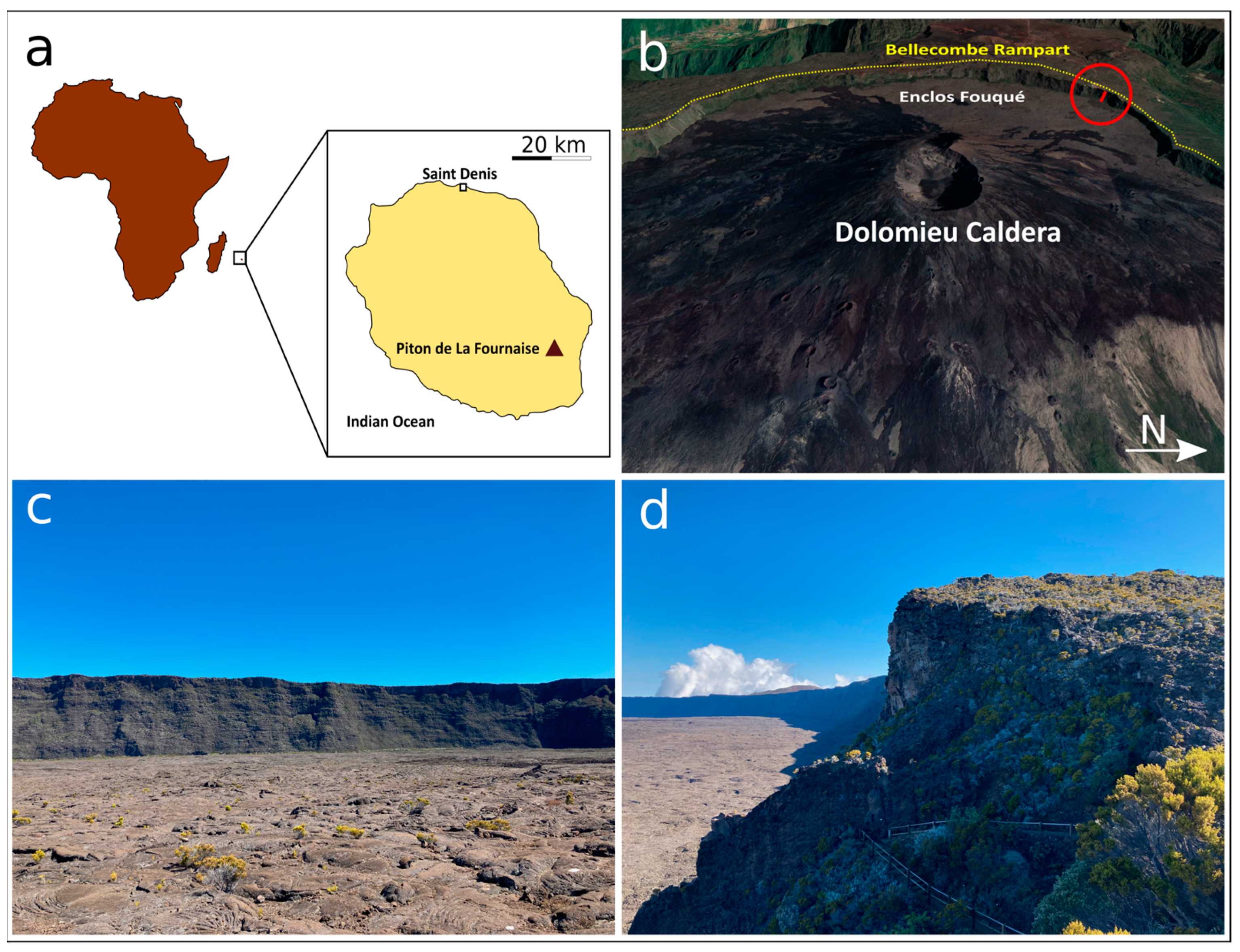
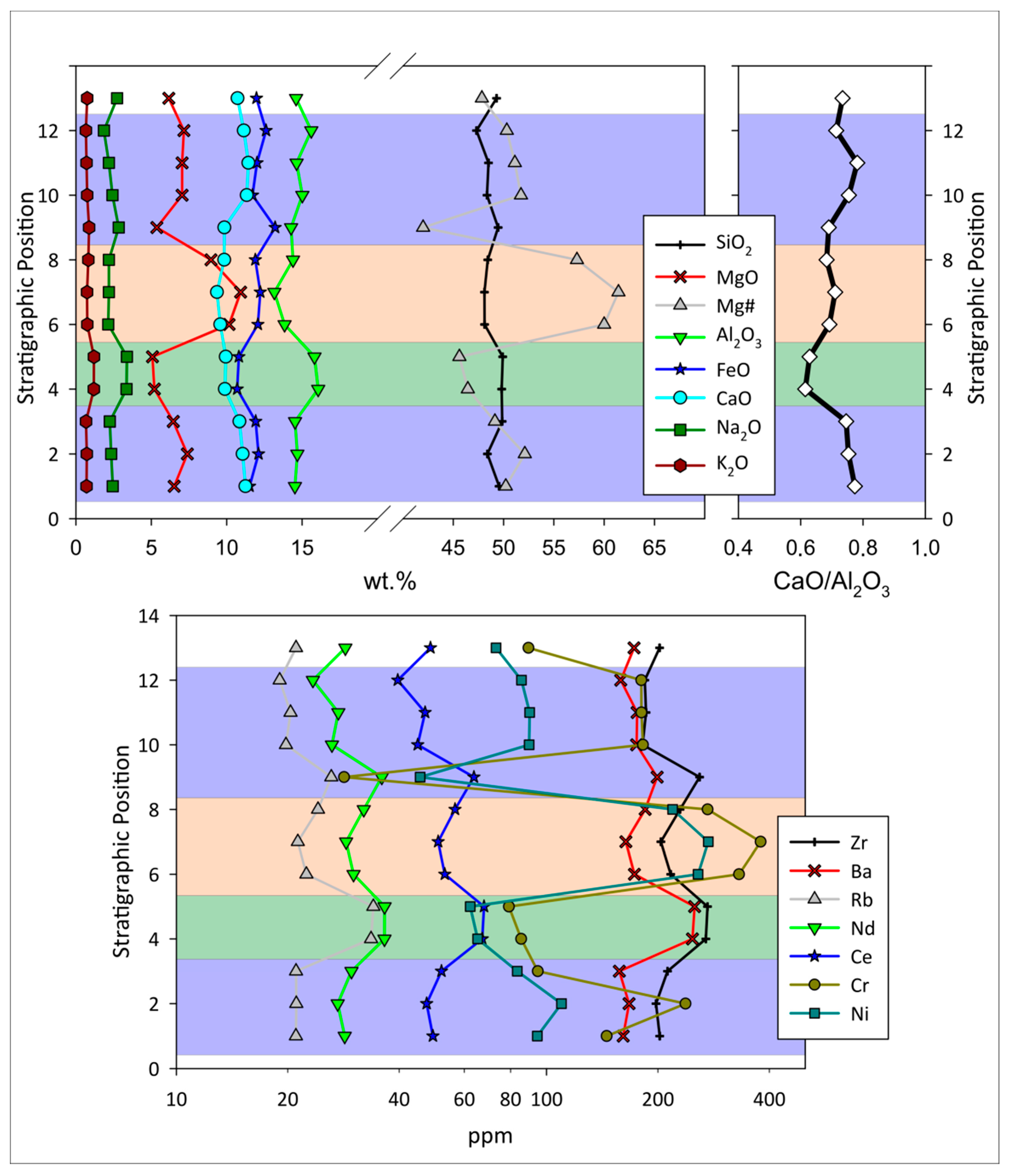
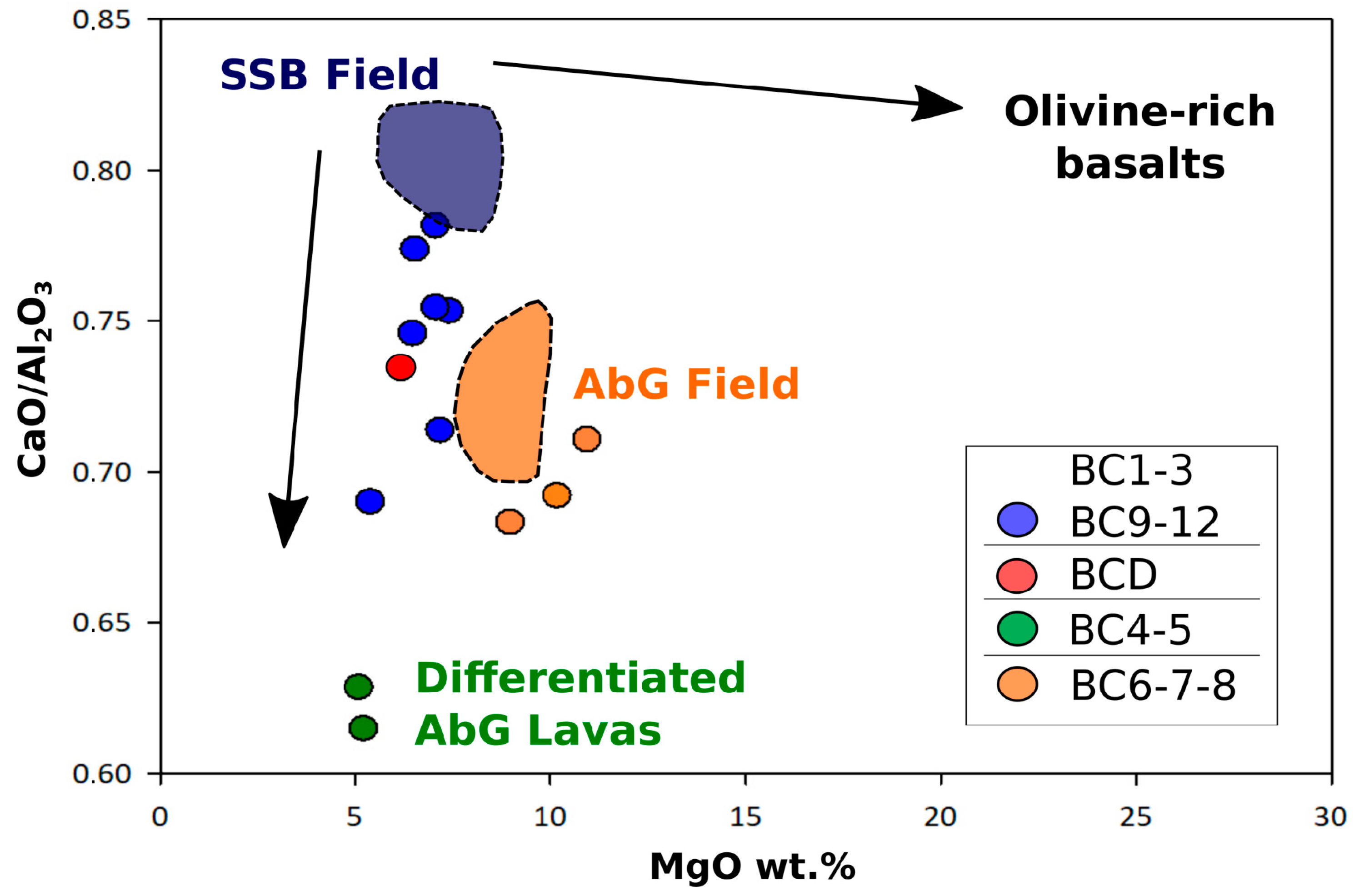
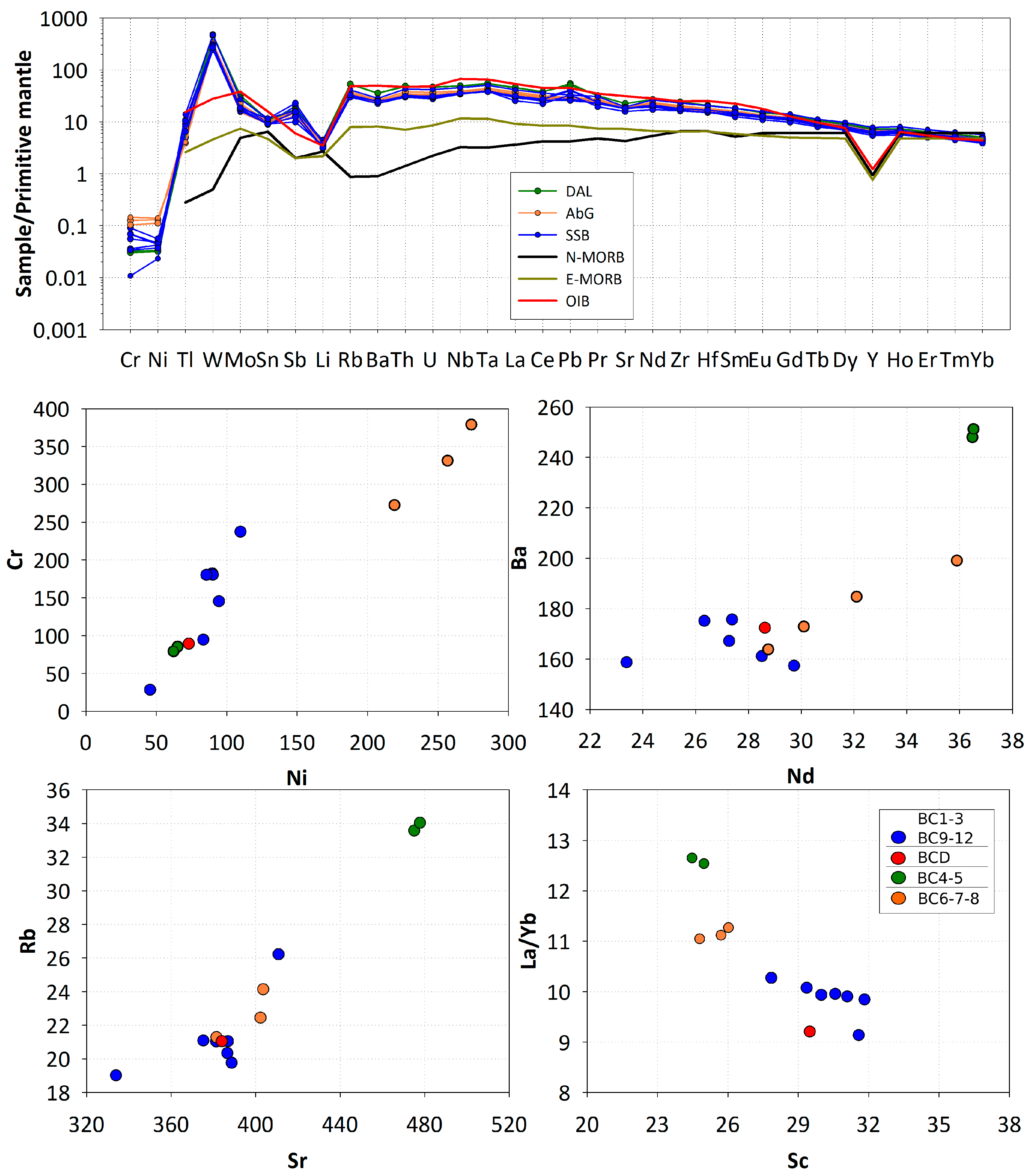

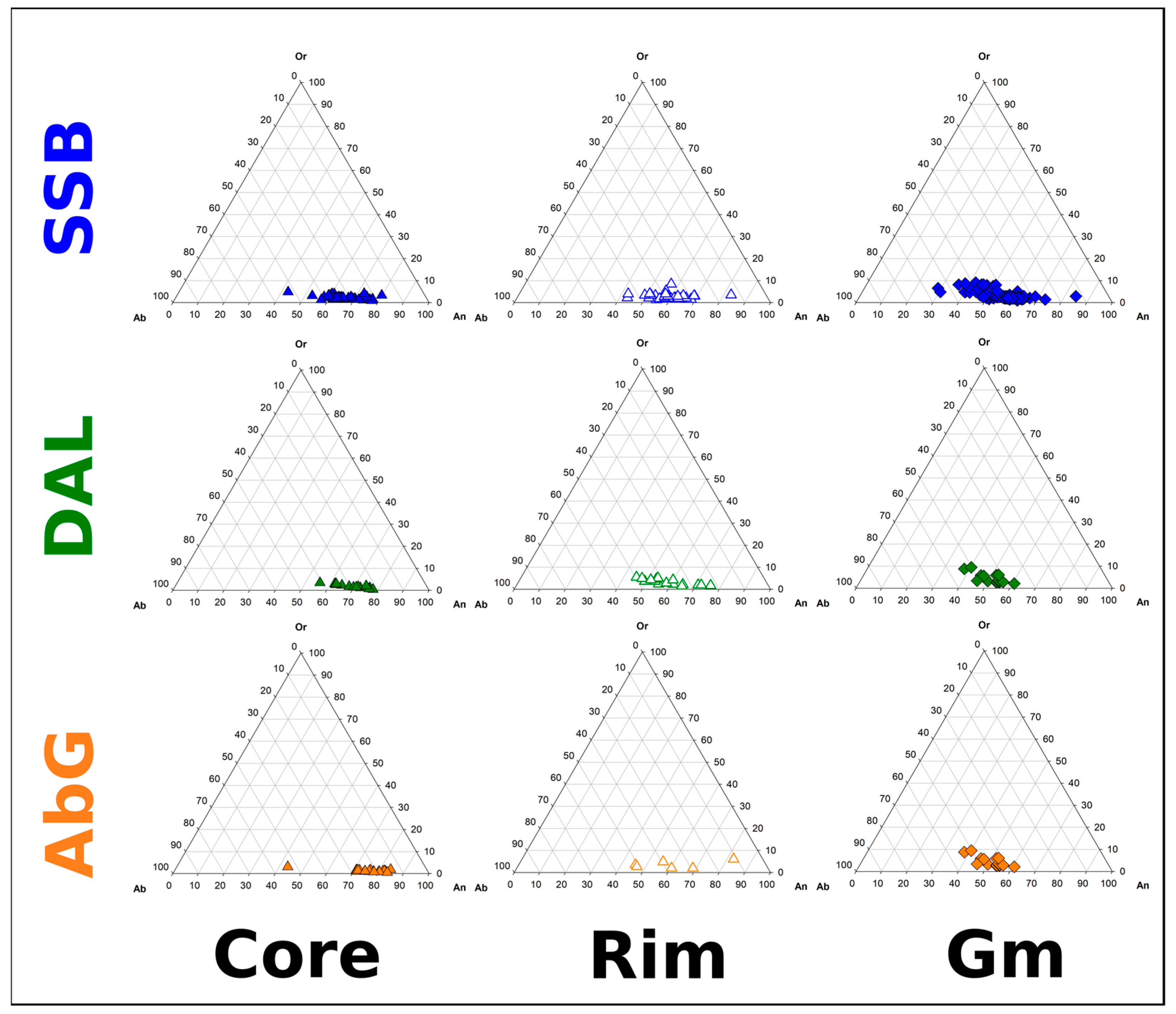
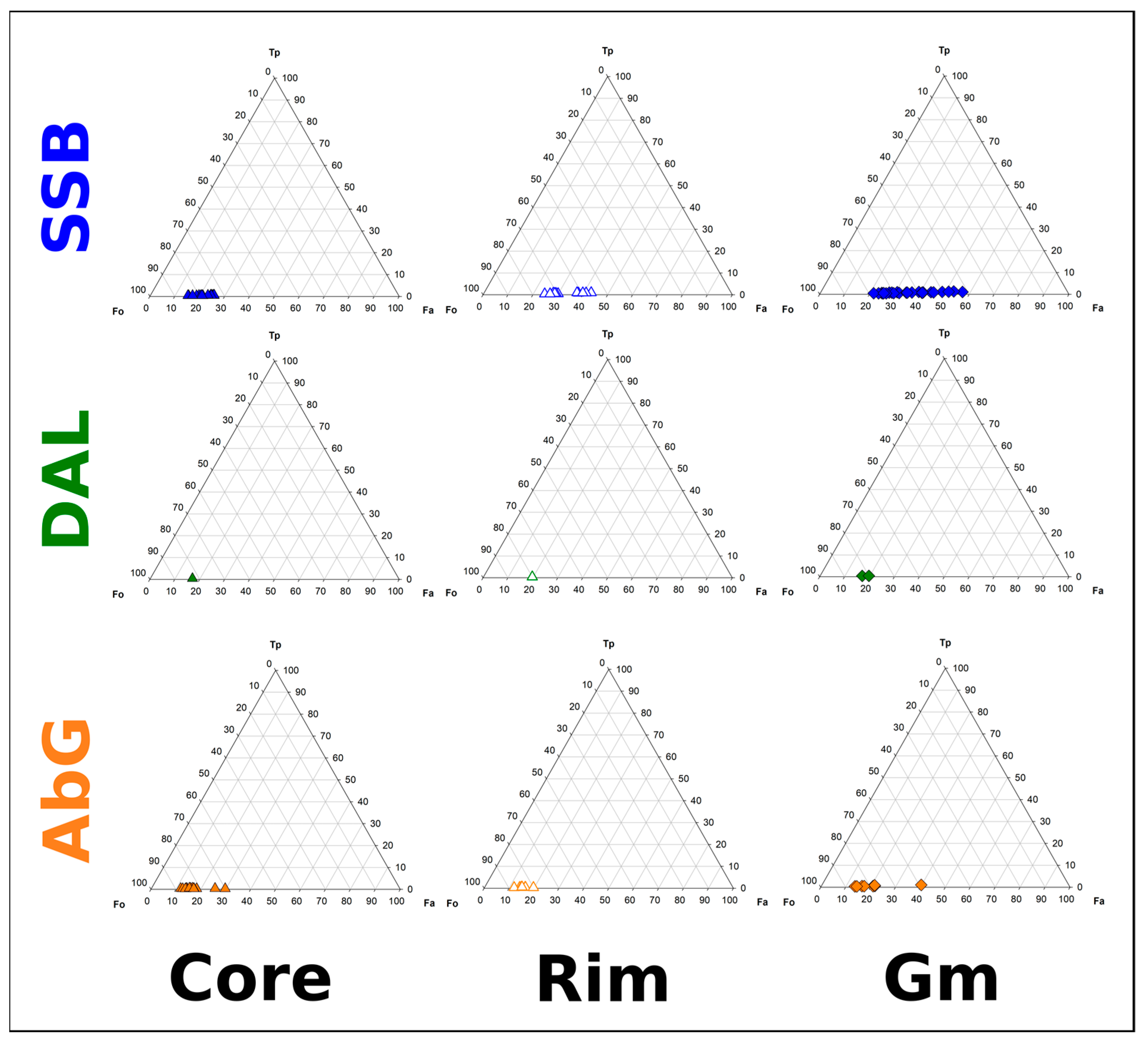
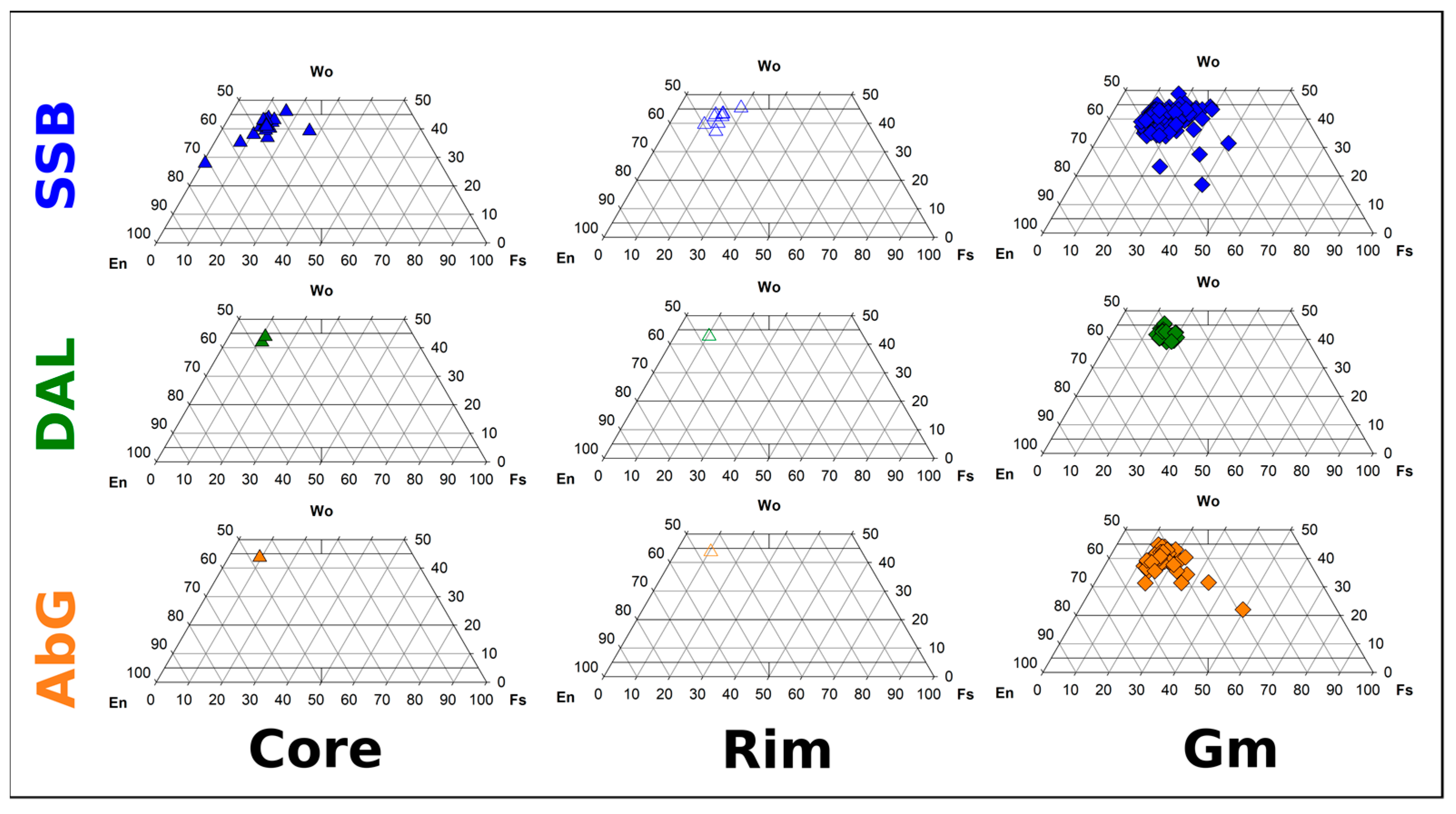
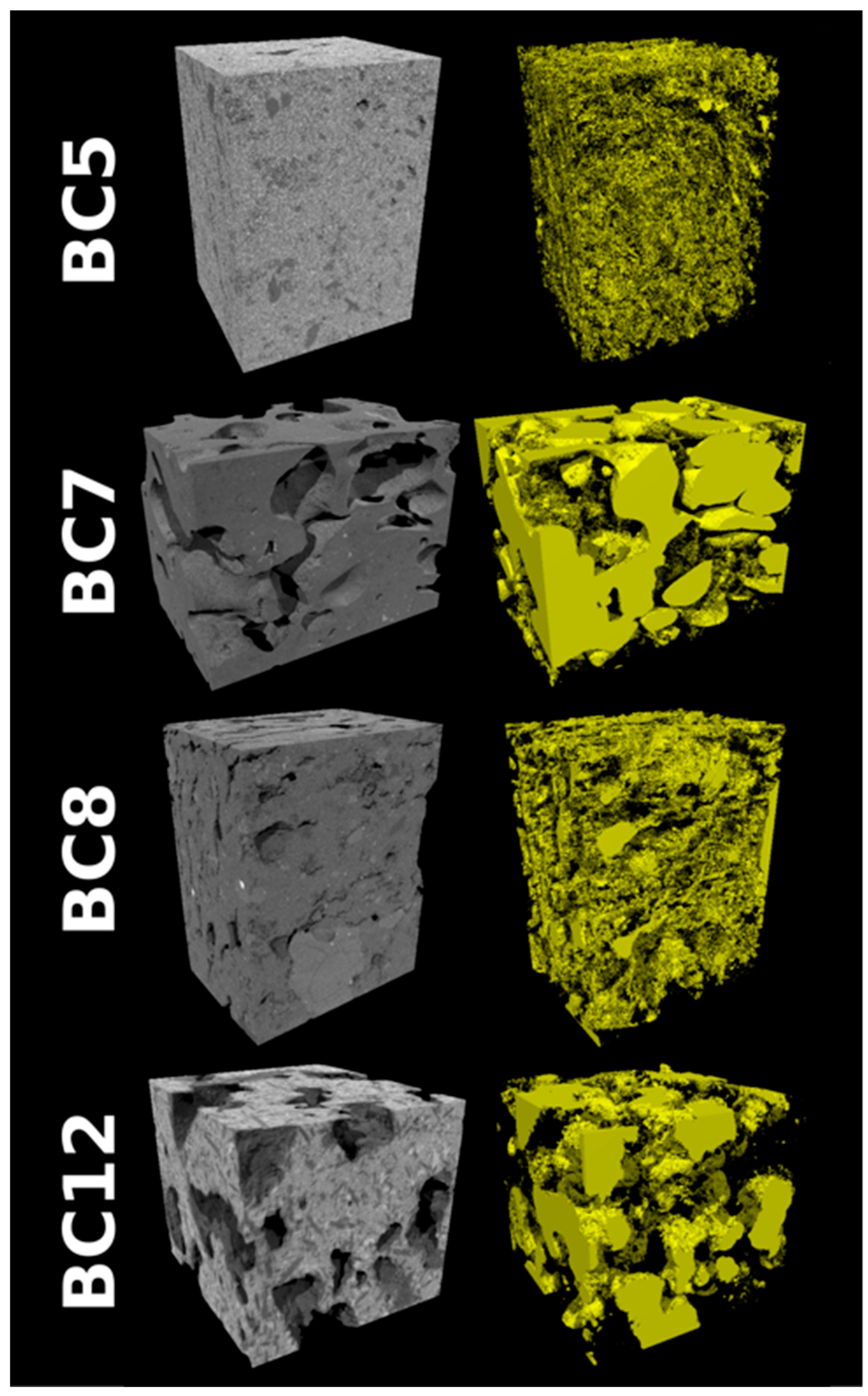
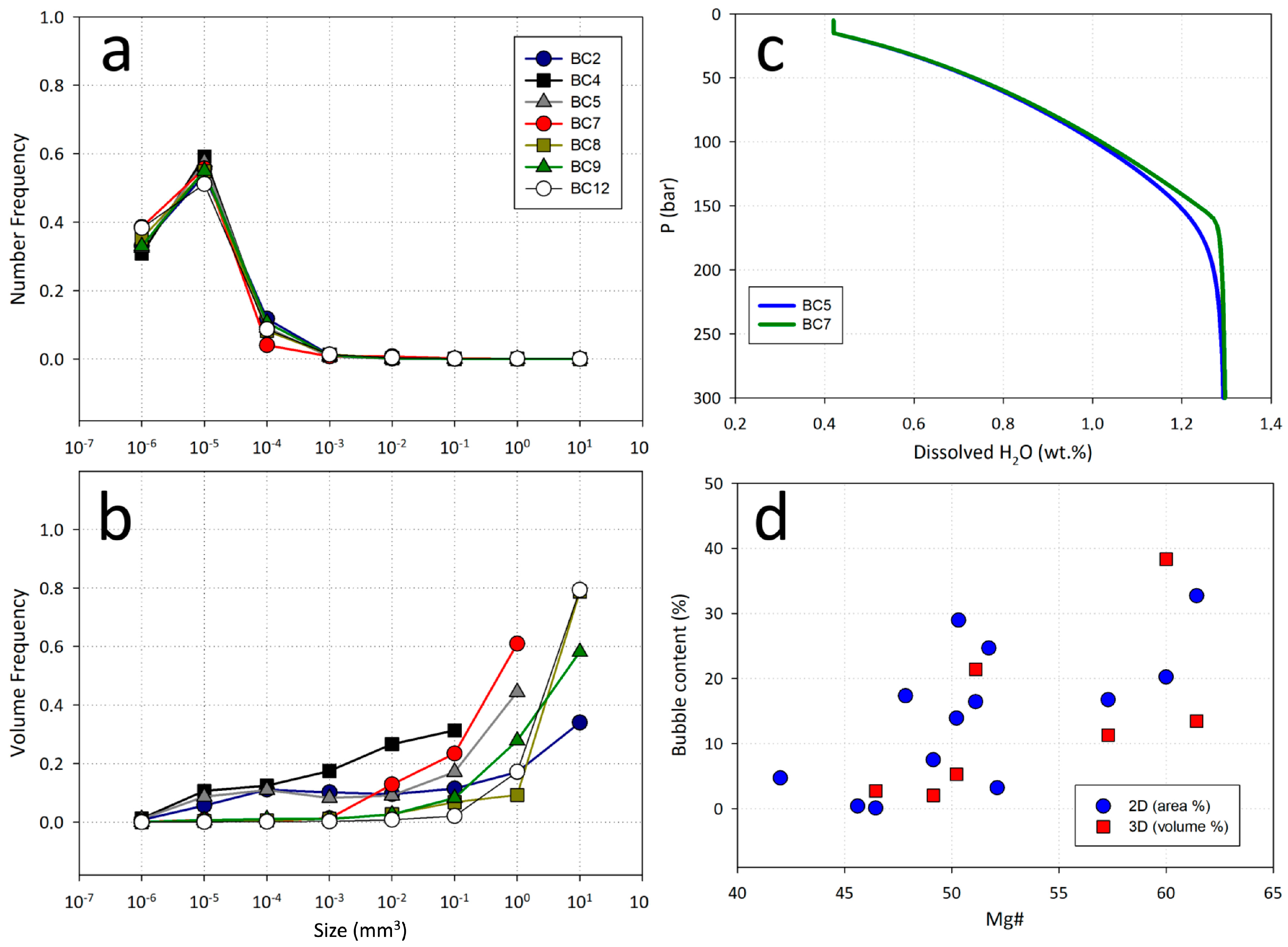
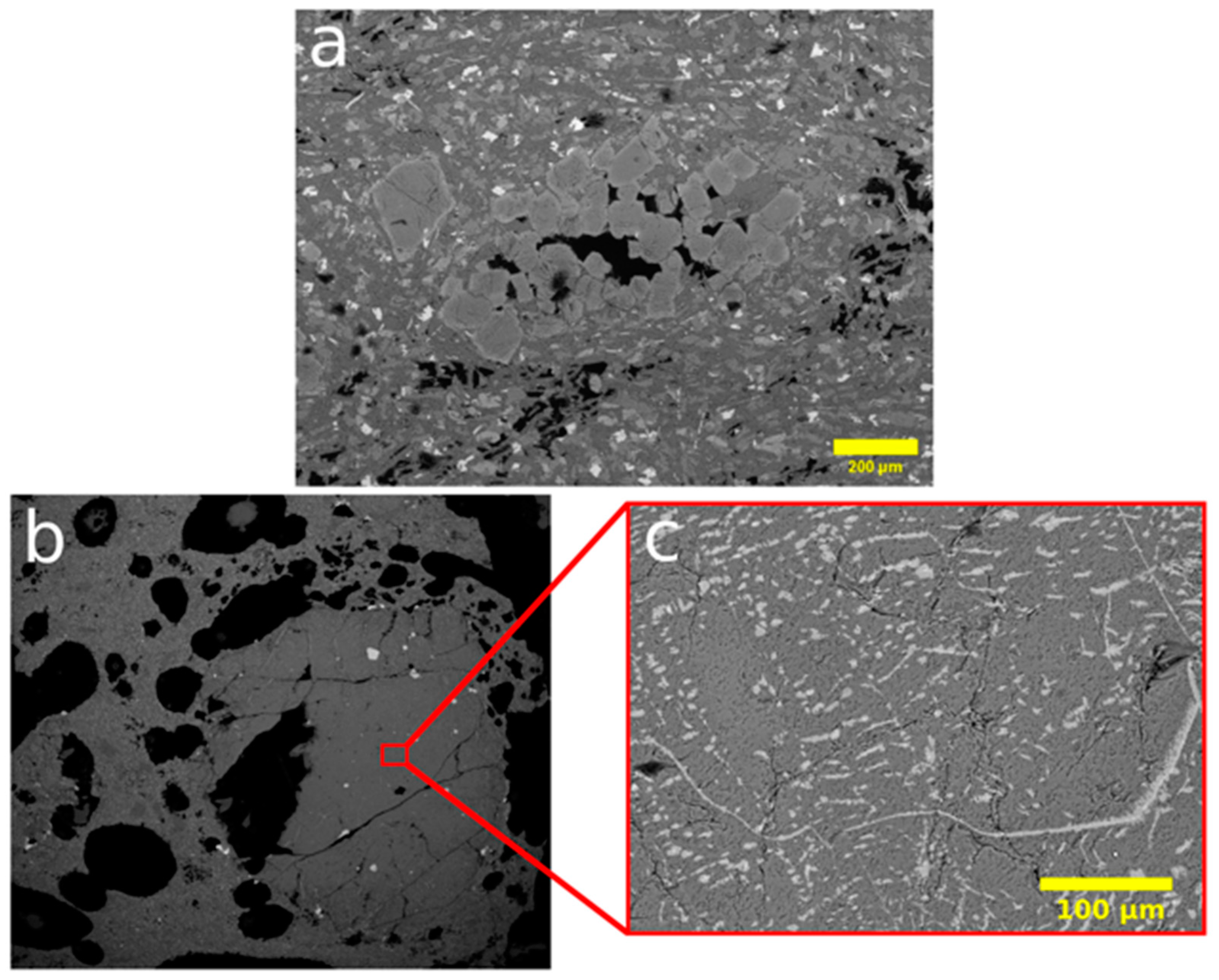
| BC1 | BC2 | BC3 | BC4 | BC5 | BC6 | BC7 | BC8 | BC9 | BC10 | BC11 | BC12 | BCD | |
|---|---|---|---|---|---|---|---|---|---|---|---|---|---|
| Major oxides (wt.%) | |||||||||||||
| SiO2 | 47.06 | 46.57 | 47.36 | 47.65 | 47.07 | 44.96 | 44.89 | 45.80 | 46.53 | 45.74 | 46.29 | 43.96 | 46.59 |
| TiO2 | 2.80 | 2.66 | 2.76 | 3.00 | 3.00 | 2.58 | 2.53 | 2.72 | 3.26 | 2.69 | 2.80 | 2.87 | 3.01 |
| Al2O3 | 13.80 | 14.14 | 13.81 | 15.38 | 14.92 | 12.94 | 12.29 | 13.63 | 13.43 | 14.21 | 13.97 | 14.51 | 13.80 |
| FeO | 12.16 | 12.96 | 12.59 | 11.37 | 11.33 | 12.54 | 12.69 | 12.51 | 13.82 | 12.32 | 12.74 | 13.02 | 12.58 |
| MgO | 6.19 | 7.12 | 6.14 | 4.98 | 4.79 | 9.50 | 10.20 | 8.48 | 5.05 | 6.67 | 6.72 | 6.66 | 5.82 |
| MnO | 0.17 | 0.18 | 0.18 | 0.16 | 0.16 | 0.18 | 0.18 | 0.18 | 0.19 | 0.17 | 0.18 | 0.18 | 0.18 |
| CaO | 10.68 | 10.65 | 10.30 | 9.45 | 9.38 | 8.96 | 8.73 | 9.31 | 9.27 | 10.73 | 10.92 | 10.36 | 10.13 |
| Na2O | 2.33 | 2.26 | 2.14 | 3.21 | 3.19 | 2.01 | 2.05 | 2.08 | 2.68 | 2.30 | 2.09 | 1.73 | 2.58 |
| K2O | 0.67 | 0.70 | 0.64 | 1.14 | 1.13 | 0.71 | 0.69 | 0.78 | 0.82 | 0.71 | 0.68 | 0.62 | 0.71 |
| P2O5 | 0.32 | 0.32 | 0.33 | 0.47 | 0.46 | 0.34 | 0.35 | 0.36 | 0.40 | 0.31 | 0.32 | 0.31 | 0.34 |
| L.O.I. | 0.61 | 0.66 | 0.54 | 0.21 | 0.11 | 0.81 | 0.97 | 0.94 | 0.51 | 0.41 | 0.81 | 1.62 | 0.04 |
| Total | 96.79 | 98.20 | 96.79 | 97.01 | 95.53 | 95.53 | 95.57 | 96.78 | 95.97 | 96.26 | 97.51 | 95.85 | 95.77 |
| Mg# | 50.22 | 52.12 | 49.14 | 46.45 | 45.60 | 60.00 | 61.42 | 57.30 | 42.00 | 51.73 | 51.11 | 50.32 | 47.84 |
| A.I. | −0.75 | −0.40 | −1.09 | 0.55 | 0.54 | −0.46 | −0.43 | −0.47 | −0.15 | −0.28 | −0.62 | −0.55 | −0.33 |
| Trace elements (ppm) | |||||||||||||
| As | 0.67 | 0.60 | 0.68 | 1.00 | 0.88 | 0.61 | 0.83 | 0.63 | 0.80 | 0.62 | 0.73 | 0.71 | 0.73 |
| Ba | 161 | 167 | 157 | 248 | 251 | 173 | 164 | 185 | 199 | 175 | 176 | 159 | 172 |
| Be | 0.76 | 0.68 | 0.78 | 1.25 | 1.24 | 0.80 | 0.78 | 0.84 | 1.10 | 0.59 | 0.76 | 0.56 | 1.36 |
| Cd | 0.25 | 0.38 | 0.40 | 0.29 | 0.32 | 0.44 | 0.56 | 0.69 | 0.39 | 0.22 | 0.40 | 0.27 | 0.61 |
| Ce | 49.33 | 47.44 | 52.03 | 67.04 | 67.77 | 53.13 | 50.94 | 56.60 | 63.65 | 44.88 | 46.99 | 39.65 | 48.57 |
| Co | 41.30 | 48.84 | 45.19 | 35.38 | 35.36 | 55.58 | 56.24 | 52.02 | 44.67 | 44.49 | 45.72 | 44.11 | 42.64 |
| Cr | 145.44 | 237.40 | 94.72 | 85.43 | 79.18 | 331.28 | 379.03 | 272.58 | 28.40 | 182.31 | 180.49 | 180.33 | 89.41 |
| Cu | 122.31 | 41.93 | 126.21 | 66.68 | 59.02 | 61.97 | 56.32 | 70.77 | 90.22 | 69.32 | 103.53 | 105.22 | 90.91 |
| Dy | 5.89 | 5.74 | 6.30 | 6.65 | 6.72 | 5.76 | 5.56 | 6.15 | 7.20 | 5.43 | 5.72 | 5.14 | 5.97 |
| Er | 2.75 | 2.65 | 2.96 | 3.12 | 3.08 | 2.70 | 2.56 | 2.85 | 3.39 | 2.54 | 2.66 | 2.42 | 2.78 |
| Eu | 2.13 | 2.10 | 2.25 | 2.52 | 2.56 | 2.18 | 2.05 | 2.29 | 2.64 | 2.02 | 2.09 | 1.85 | 2.17 |
| Ga | 16.95 | 16.68 | 17.30 | 18.34 | 19.35 | 16.36 | 15.47 | 16.41 | 19.47 | 16.59 | 16.59 | 16.40 | 18.07 |
| Gd | 7.02 | 6.61 | 7.31 | 8.08 | 8.06 | 6.88 | 6.60 | 7.26 | 8.41 | 6.40 | 6.74 | 5.89 | 7.10 |
| Ge | 0.73 | 0.78 | 0.78 | 0.80 | 0.86 | 0.78 | 0.77 | 0.84 | 0.91 | 0.71 | 0.74 | 0.78 | 0.88 |
| Hf | 5.02 | 5.00 | 5.28 | 6.43 | 6.43 | 5.25 | 4.94 | 5.58 | 6.32 | 4.69 | 4.73 | 4.81 | 5.20 |
| Ho | 1.07 | 1.05 | 1.15 | 1.21 | 1.21 | 1.06 | 0.99 | 1.11 | 1.32 | 0.98 | 1.04 | 0.93 | 1.11 |
| La | 22.35 | 21.29 | 23.53 | 31.24 | 31.62 | 24.21 | 23.10 | 25.96 | 28.50 | 20.20 | 21.31 | 17.55 | 21.77 |
| Li | 5.82 | 6.06 | 5.75 | 7.13 | 7.15 | 6.08 | 5.85 | 5.86 | 7.04 | 5.61 | 4.98 | 5.07 | 6.23 |
| Lu | 0.31 | 0.31 | 0.34 | 0.36 | 0.35 | 0.31 | 0.30 | 0.33 | 0.40 | 0.30 | 0.31 | 0.28 | 0.33 |
| Mo | 1.28 | 1.17 | 1.29 | 2.03 | 1.82 | 1.12 | 0.97 | 1.41 | 1.72 | 1.03 | 1.12 | 1.12 | 1.17 |
| Nb | 25.41 | 25.89 | 26.47 | 34.92 | 35.29 | 26.60 | 25.28 | 28.04 | 32.67 | 24.42 | 24.95 | 24.80 | 25.46 |
| Nd | 28.51 | 27.27 | 29.73 | 36.48 | 36.52 | 30.10 | 28.75 | 32.10 | 35.89 | 26.33 | 27.38 | 23.39 | 28.63 |
| Ni | 94.45 | 109.79 | 83.36 | 65.15 | 62.22 | 256.79 | 273.62 | 219.09 | 45.55 | 89.77 | 90.08 | 85.54 | 73.07 |
| Pb | 1.88 | 2.16 | 2.92 | 3.89 | 3.63 | 2.07 | 1.81 | 2.11 | 2.34 | 1.99 | 1.84 | 2.35 | 2.84 |
| Pr | 6.70 | 6.38 | 7.00 | 8.77 | 8.86 | 7.04 | 6.78 | 7.55 | 8.51 | 6.13 | 6.37 | 5.42 | 6.64 |
| Rb | 21.03 | 21.09 | 21.05 | 33.58 | 34.05 | 22.45 | 21.29 | 24.15 | 26.22 | 19.77 | 20.35 | 19.02 | 21.05 |
| Sb | 0.10 | 0.07 | 0.08 | 0.09 | 0.09 | 0.07 | 0.06 | 0.08 | 0.08 | 0.05 | 0.08 | 0.06 | 0.11 |
| Sc | 29.36 | 30.57 | 29.98 | 24.98 | 24.48 | 25.71 | 24.80 | 26.03 | 27.85 | 31.08 | 31.82 | 31.57 | 29.49 |
| Sm | 6.60 | 6.42 | 6.90 | 8.09 | 8.08 | 6.75 | 6.42 | 7.17 | 8.13 | 6.06 | 6.33 | 5.58 | 6.66 |
| Sn | 1.63 | 1.52 | 1.65 | 1.90 | 1.83 | 1.61 | 1.55 | 1.75 | 1.99 | 1.56 | 1.51 | 1.57 | 1.96 |
| Sr | 381 | 375 | 387 | 475 | 478 | 402 | 381 | 404 | 411 | 389 | 387 | 334 | 384 |
| Ta | 1.63 | 1.68 | 1.67 | 2.22 | 2.26 | 1.68 | 1.60 | 1.80 | 2.08 | 1.59 | 1.62 | 1.59 | 1.57 |
| Tb | 1.01 | 0.96 | 1.06 | 1.15 | 1.15 | 0.99 | 0.94 | 1.06 | 1.21 | 0.92 | 0.97 | 0.87 | 1.02 |
| Th | 2.78 | 2.85 | 2.90 | 4.08 | 4.17 | 2.96 | 2.96 | 3.23 | 3.64 | 2.56 | 2.57 | 2.54 | 2.66 |
| Tl | 0.03 | 0.02 | 0.05 | 0.04 | 0.03 | 0.02 | 0.02 | 0.04 | 0.07 | 0.03 | 0.05 | 0.03 | 0.05 |
| Tm | 0.37 | 0.37 | 0.40 | 0.43 | 0.43 | 0.37 | 0.35 | 0.39 | 0.47 | 0.34 | 0.36 | 0.33 | 0.38 |
| U | 0.66 | 0.68 | 0.71 | 0.99 | 0.99 | 0.71 | 0.68 | 0.78 | 0.88 | 0.58 | 0.62 | 0.63 | 0.66 |
| V | 292 | 311 | 296 | 289 | 298 | 260 | 249 | 258 | 354 | 298 | 300 | 301 | 314 |
| W | 6.54 | 6.67 | 6.71 | 9.62 | 9.29 | 6.39 | 5.23 | 6.64 | 9.47 | 4.97 | 6.15 | 5.86 | 5.41 |
| Y | 28.94 | 27.93 | 31.50 | 33.01 | 33.43 | 28.84 | 27.54 | 30.55 | 35.68 | 26.80 | 27.87 | 24.79 | 29.29 |
| Yb | 2.22 | 2.14 | 2.37 | 2.49 | 2.50 | 2.18 | 2.09 | 2.30 | 2.77 | 2.04 | 2.16 | 1.92 | 2.36 |
| Zn | 104 | 111 | 112 | 103 | 108 | 109 | 108 | 110 | 132 | 103 | 107 | 105 | 110 |
| Zr | 202 | 198 | 212 | 270 | 272 | 217 | 204 | 229 | 259 | 182 | 186 | 184 | 202 |
| Plg | Cpx | Ol | PI | Ves | |
|---|---|---|---|---|---|
| BC1 | 1.28 | <0.1 | <0.1 | 1.28 | 13.91 |
| BC2 | <0.1 | <0.1 | 0.31 | 0.31 | 3.21 |
| BC3 | 0.76 | 0.11 | 0.33 | 1.19 | 7.52 |
| BC4 | 3.91 | 1.71 | 0.70 | 6.32 | 0.10 |
| BC5 | 4.93 | 0.20 | 0.10 | 5.24 | 0.40 |
| BC6 | 3.77 | 4.27 | 1.63 | 9.67 | 20.24 |
| BC7 | 2.68 | 2.98 | 15.05 | 20.72 | 32.70 |
| BC8 | 2.53 | 1.56 | 7.58 | 11.67 | 16.73 |
| BC9 | 1.89 | 0.32 | 0.74 | 2.95 | 4.71 |
| BC10 | 3.60 | 0.27 | 1.73 | 5.59 | 24.67 |
| BC11 | 17.15 | 2.04 | 12.83 | 32.01 | 16.43 |
| BC12 | 16.22 | 0.56 | 3.53 | 20.31 | 28.96 |
| BCD | 0.61 | 0.24 | 0.24 | 1.09 | 17.33 |
| Sample | VOI (mm3) | BND (#/mm3) | Amount (vol.%) | E | I | Vol (mm3) | S |
|---|---|---|---|---|---|---|---|
| BC2 | 592.70 | 179 | 5.28 | 0.05 | 0.90 | 0.0003 | 0.81 |
| BC4 | 720.78 | 119 | 2.04 | 0.03 | 0.87 | 0.0002 | 0.82 |
| BC5 | 702.03 | 134 | 2.73 | 0.03 | 0.90 | 0.0002 | 0.82 |
| BC7 | 584.20 | 21 | 38.34 | 0.06 | 0.81 | 0.0183 | 0.86 |
| BC8 | 705.97 | 39 | 13.46 | 0.06 | 0.80 | 0.0035 | 0.84 |
| BC9 | 625.05 | 46 | 11.31 | 0.04 | 0.89 | 0.0025 | 0.82 |
| BC12 | 646.89 | 14 | 21.40 | 0.04 | 0.95 | 0.0149 | 0.84 |
Disclaimer/Publisher’s Note: The statements, opinions and data contained in all publications are solely those of the individual author(s) and contributor(s) and not of MDPI and/or the editor(s). MDPI and/or the editor(s) disclaim responsibility for any injury to people or property resulting from any ideas, methods, instructions or products referred to in the content. |
© 2023 by the authors. Licensee MDPI, Basel, Switzerland. This article is an open access article distributed under the terms and conditions of the Creative Commons Attribution (CC BY) license (https://creativecommons.org/licenses/by/4.0/).
Share and Cite
Lanzafame, G.; Bolam, A.; Di Muro, A.; Portale, S.; Donato, S.; Besson, P.; Ferlito, C. Geochemistry and Petrology of the Bellecombe Lava Sequence, Enclos Fouqué Caldera, Piton de la Fournaise Volcano (Réunion, France). Minerals 2023, 13, 751. https://doi.org/10.3390/min13060751
Lanzafame G, Bolam A, Di Muro A, Portale S, Donato S, Besson P, Ferlito C. Geochemistry and Petrology of the Bellecombe Lava Sequence, Enclos Fouqué Caldera, Piton de la Fournaise Volcano (Réunion, France). Minerals. 2023; 13(6):751. https://doi.org/10.3390/min13060751
Chicago/Turabian StyleLanzafame, Gabriele, Alexander Bolam, Andrea Di Muro, Silvia Portale, Sandro Donato, Pascale Besson, and Carmelo Ferlito. 2023. "Geochemistry and Petrology of the Bellecombe Lava Sequence, Enclos Fouqué Caldera, Piton de la Fournaise Volcano (Réunion, France)" Minerals 13, no. 6: 751. https://doi.org/10.3390/min13060751
APA StyleLanzafame, G., Bolam, A., Di Muro, A., Portale, S., Donato, S., Besson, P., & Ferlito, C. (2023). Geochemistry and Petrology of the Bellecombe Lava Sequence, Enclos Fouqué Caldera, Piton de la Fournaise Volcano (Réunion, France). Minerals, 13(6), 751. https://doi.org/10.3390/min13060751








